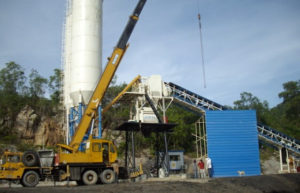How to measure aggregate moisture in a concrete mixing plant?
Inaccurate measuring of aggregate moisture increases production costs

The biggest problem in connection with the concrete production is the variation in aggregate moisture and therefore it is an important task to make sure that measuring of the aggregate moisture is easy and as accurate as possible.
To be able to use aggregate moisture values for the calculation of material amounts for the actual concrete batch, reliable real time information of the moisture content is required. The moisture-% and with this the amount of water contained in the aggregates massively influence the water content and at the same time the consistency and the quality of a concrete mix.
For dosing the right amount of water according to the target W/C- respectively W/B-value
the target amount of total water needs to be set referring to the actual mix design,
the total amount of water contained in the different aggregate fractions needs to be identified,
which then allows to calculate
the target amount of water to be dosed from the water scale and added to the mix.
For example:
There is a 3 m3 concrete batch, containing 6,000 kg aggregates with an aggregate moisture of 4%, which results in 240 kg water brought in by the aggregates.
Given that the deviation of the aggregate moisture measuring is +-1%, the variation of the aggregate water content is plus or minus 60 kg.
In daily work in a concrete plant, inaccurate moisture measuring is compensated by manual water reduction or dosing additional water based on the ampere meter showing the power used by the concret mixer motor/s. This manual adjusting leads to inconstant consistency and concrete quality, prolongs the dosing and mixing time and by this reduces the production capacity and generates unnecessary wear in the concret mixer.